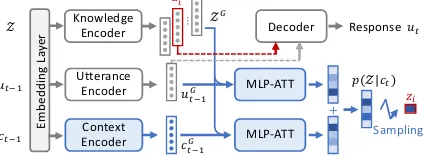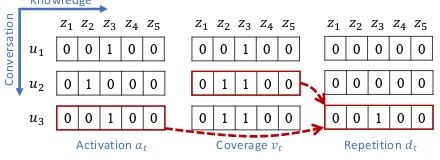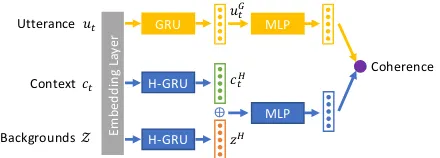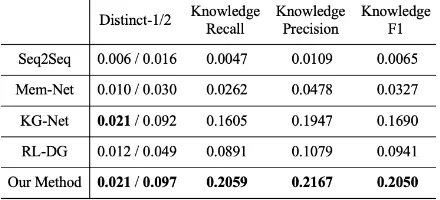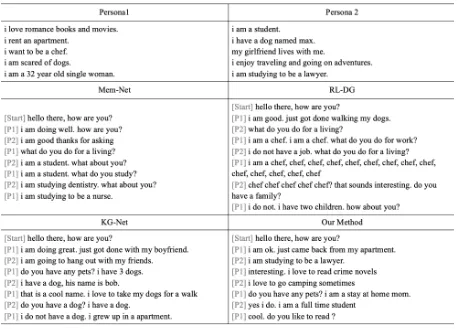5382
Know More about Each Other: Evolving Dialogue Strategy via
Compound Assessment
Siqi Bao, Huang He, Fan Wang, Rongzhong Lian and Hua Wu
Baidu Inc., China
{baosiqi, hehuang, wangfan04, lianrongzhong, wu hua}@baidu.com
Abstract
In this paper, a novel Generation-Evaluation framework is developed for multi-turn conver-sations with the objective of letting both par-ticipants know more about each other. For the sake of rational knowledge utilization and co-herent conversation flow, a dialogue strategy which controls knowledge selection is instan-tiated and continuously adapted via reinforce-ment learning. Under the deployed strategy, knowledge grounded conversations are con-ducted with two dialogue agents. The gener-ated dialogues are comprehensively evalugener-ated on aspects like informativeness and coherence, which are aligned with our objective and hu-man instinct. These assessments are integrated as a compound reward to guide the evolution of dialogue strategy via policy gradient. Com-prehensive experiments have been carried out on the publicly available dataset, demonstrat-ing that the proposed method outperforms the other state-of-the-art approaches significantly.
1 Introduction
Intelligent dialogue systems have become popu-lar in our daily life, such as the chit-chat XiaoIce and the task-oriented Echo. These systems serve as smart agents to facilitate more effective inter-action with users in various situations, like ticket booking or recreation offering. Primary dialogue systems (Vinyals and Le,2015;Shang et al.,2015) try to mimic human beings to generate fluent utter-ances, whereas paying little attention to the intrin-sic factors of human conversations: exchanging
information and enhancing interaction(Li et al.,
2017). Therefore, they are prone to generate dull and generic responses.
To address this problem, in recent years, sev-eral approaches have been developed to generate informative responses based on external knowl-edge. Recently, a knowledge grounded model is
proposed in Ghazvininejad et al. (2018), where relevant factual texts are encoded into memory and replies are decoded via attention mechanism. In-stead of using unstructured text knowledge, CCM (Zhou et al.,2018) relies on structured knowledge to generate rich-information response. However, all these approaches are designed for the single-round settings. While applied to the real-world scenarios (where dialogues are conducted for mul-tiple rounds), the dialogue quality will be severely limited due to the lack of coordination among dif-ferent rounds.
As discussed above, one of the ultimate goals in human conversation is that information can be exchanged effectively through interaction. Par-ticularly, we argue that successful multi-turn di-alogues are determined by the joint experience of both participants in the conversation, i.e., both participants need to get aware of their counter-parts and express themselves effectively. To this end, we propose the objective of letting both sides know more about each other. With this objective, a novel Generation-Evaluation framework is intro-duced for the multi-turn dialogues.
As the name Generation-Evaluation indicates, there are two fundamental modules in our frame-work. In the module of dialogue generation, a two-stage generative model is employed, where the dialogue strategy determines which knowledge to use for the current turn and the decoder uses this knowledge to produce the response. In the mod-ule of evaluation, the generated dialogues are as-sessed from the following two aspects:
informa-tiveness, which measures the effectiveness of
! " Namaste. How are you today?
I am doing great. How are you?
Great, thanks. My children and I were just about to watch Game of Thrones.
Nice. How old are you children?
…
Dialogue Generation
Informativeness Coherence
Strategy Evaluation
Compound Reward Dialogue
Reward
Backgrounds
I have four children I love watching Game of Thrones…
…
I like to ski I hate Mexican food
Encourage informative & concise conversations to
exchange information
Generate coherent & proper responses to
enhance interaction
[image:2.595.76.525.68.164.2]Coverage Duplication Relevance Consistency
Figure 1: Framework overview. Left: dialogue generation. Right: strategy evaluation.
evaluation module. By keeping adapted for higher evaluation rewards, the generation module will be continuously evolving for better dialogue quality. As suggested in Yarats and Lewis(2018), apply-ing reinforcement learnapply-ing on the decoder might bring in adverse impacts on the linguistic quality. As such, in the generation module, the decoder is pre-trained with supervised learning and the dia-logue strategy keeps evolving with reinforcement learning.
The contributions of this work are summarized as follows:
• With the objective of letting both partici-pants know more about each other, we pro-pose a novel Generation-Evaluation frame-work, which facilitates the generation of in-formative and coherent dialogues.
• To evaluate the effectiveness of dialogue strategy, two metrics are specially designed on informativeness and coherence, which are further integrated as a compound reward. To-wards maximizing this reward, the strategy of knowledge selection is able to evolve via re-inforcement learning.
• Intensive and extensive experiments have been carried out on PersonaChat. As com-pared with other state-of-the-art approaches, our method obtains superior performances on both automatic and human evaluations.
2 Methodology
2.1 Framework Overview
Our Generation-Evaluation framework is illus-trated in Figure 1. Under the deployed strategy of knowledge selection, two dialogue agents in-troduce themselves alternately in accordance with corresponding backgrounds and make responses
Utterance Encoder
Context Encoder Knowledge
Encoder
!"#$
%
&"#$
…
MLP-ATT
MLP-ATT
+
Decoder Response!"
Sampling () ()*
!"#$*
&"#$*
%*
+(%|&")
Em
be
dd
in
g
La
ye
r
Figure 2: Architecture of dialogue generation.
to their counterparts in a proper way. The gen-erated dialogues together with the agents’ back-grounds are collected for strategy evaluation in terms of two essential aspects: informativeness and coherence. Then these assessments are inte-grated as a compound reward, acting as the reforcing signal for the evolution of knowledge in-teraction strategy.
In the following parts, we will first introduce the process of dialogue generation, present the metrics utilized in strategy evaluation and then describe the strategy evolution via compound assessment.
2.2 Dialogue Generation
The detailed network architecture of dialogue gen-eration is illustrated in Figure 2. With the con-text and background knowledge as input, our di-alogue strategy selects one piece of appropriate knowledge to generate informative and coherent response. The backgroundZ ={z1, z2,· · · , zM}
includes a set of knowledge, where a piece of knowledge zi is presented by one sentence, such
as “i like to ski”. Utterance ut−1 is the last re-sponse from the other participant and the context
ct =concat(u1, u2,· · · , ut−1)is the current con-versation history.
It is worth noting that in our dialogue gener-ation, the input context ct is separated into two
[image:2.595.310.522.216.295.2]sake of coherence, the knowledge utilized int-th turn is supposed to be semantically related to the partner’s last utterance ut−1; to avoid repetition, the knowledge utilized int-th turn should be dis-similar with the former dialogue historyct−1.
After passing through the embedding layer and the encoders of gated recurrent unit (GRU) (Cho et al.,2014), the inputs obtain their corresponding feature representation: knowledge ziG, utterance
uGt−1 and contextcGt−1. ZG = {zG
1, z2G,· · ·, zMG}
is the set of knowledge representation. With dis-criminative representations uGt−1, cGt−1 and ZG
obtained, the prior distribution over knowledge
p(Z|ct) can be estimated through MLP attention
(MLP-ATT) (Bahdanau et al.,2015):
p(Z|ct) =p(Z|ut−1)∗0.5 +p(Z|ct−1)∗0.5,
p(zi|ut−1) =softmax MLP-ATT(uGt−1, ziG)
,
p(zi|ct−1) =softmax MLP-ATT(cGt−1, ziG)
,
(1)
where softmax is defined as softmax(si) =
esi/P
jesj (Sukhbaatar et al., 2015). And the
computation of MLP-ATT is given as follows:
MLP-ATT(x, y) =V1T tanh(xW1+yW2),
where W1, W2 ∈ Rd×d and V1 ∈ Rd are
the weight matrices. p(Z|ct) is the
proba-bility distribution for knowledge selection and PM
i=1p(zi|ct) = 1. (Ifp(zi|ct) = 0.2, it means that the probability to select knowledgezi is0.2.)
According to the estimated prior probability dis-tributionp(Z|ct), one piece of knowledge can be
sampledzi ∼p(Z|ct)and sent to the decoder for
response generationp(ut|zi, ut−1).
It is obvious that the key component for in-formative and coherent conversation is the ap-propriate knowledge selection, shown as Blue ar-eas in Figure 2. Nevertheless, a high-fidelity de-coderp(ut|zi, ut−1), which is able to express the given knowledge accurately, is also indispensable. To this end, the pre-training is carried out us-ing those target responses associated with ground-truth knowledge via supervised learning. The training data is in the format of {ut−1, zi, ut},
where ut−1 is the last utterance from the part-ner,utis the target response andzi is the ground
truth knowledge used in ut. Major steps in the
pre-training are listed as follows: (1) the encoders convert the knowledge and utterance into zG
i and
uGt−1; (2) the decoder tries to generate the response
utbased on the ground-truth knowledgeziand last
0 0 1 0 0
0 1 0 0 0
0 0 1 0 0
!"
!#
!$
0 0 1 0 0
0 1 1 0 0
0 1 1 0 0
Activation %& Coverage '& Repetition (&
0 0 0 0 0
0 0 0 0 0
0 0 1 0 0
)" )# )$ )* )+ )" )# )$ )* )+ )" )# )$ )* )+
Knowledge
Co
nv
er
sa
tio
[image:3.595.307.527.66.146.2]n
Figure 3: Toy example of informativeness assessment: activationatrecords whether a piece of knowledge is
expressed inut, coveragevtkeeps track of expressed
knowledge and repetitiondtdetects reiteration.
utteranceut−1; (3) parameters in the encoders and decoder (Gray areas) are optimized via supervised leaning, with the loss functions defined in Zhao et al. (2017). For the rest of the parameters re-lated to the knowledge selection strategy (Blue ar-eas), they will keep evolving through Generation-Evaluation reinforcement learning, which will be discussed in detail.
2.3 Strategy Evaluation
Multi-turn knowledge grounded conversations are generated by two dialogue agents. To evaluate the effectiveness of deployed strategy, generated con-versations and agents’ background knowledge are collected for evaluation and two metrics are judi-ciously designed – informativeness and coherence.
2.3.1 Informativeness
Information is a crucial ingredient in generating meaningful conversations. Although many ap-proaches have been introduced to boost the gen-eration of informative utterances, due to a lack of thorough control on effective information uti-lization, they are prone to generating repetitive ut-terances in multi-turn conversations. In this pa-per, we design a novel informativeness metric to measure the effective exploitation of information in the conversation level, which encourages exten-sive coverage and avoids unnecessary repetition.
To illustrate the informativeness assessment, a toy example is given in Figure 3. Assume that there are five pieces of background knowledgezi
within the conversation participants. For each gen-erated utteranceut, it will be assessed whetherzi
is expressed by ut or not, which can be
informa-tiveness metric, it is able to boost informative re-sponse generation on the utterance level. How-ever, it inevitably produces repetitive responses due to the lack of information utilization control on the conversation level.
Inspired by the coverage mechanism in machine translation (Tu et al., 2016) and text summariza-tion (See et al., 2017), we propose to maintain one coverage vector vt to keep track of the
ac-tivation on each piece of information during the conversation flow. From the toy example, it can be observed that the coverage vectorvtincreases
with the amount of expressed knowledge. In other words, a higher mean value of vt indicates that
the participants have expressed more background knowledge, which gives a better chance for them to know more about each other.
Although the coverage mechanism stimulates extensive knowledge expression, it still lacks ef-fective and explicit control on the reiteration. For the sake of user experience, we also main-tain one repetition vectordtto detect information
redundancy, whose estimation is carried out by jointly considering current information activation and last-step coverage status:
dt= min(at, vt−1), (2)
where the functionmin(·)calculates the element-wise minimum value between two vectors. As shown in Figure3, when utteranceu3reiterates the same information as before, it does not increase knowledge coverage and leads to unnecessary rep-etition.
In summary, instead of focusing on the informa-tion activainforma-tion of the single-round response, our informativeness metric considers the effective in-formation utilization in the scope of multi-turn conversation. For a conversation withT turns, its informativeness is estimated as follows:
rI =mean(vT)−
T
X
t=1
mean(dt), (3)
where the function mean(·) calculates the mean value of a vector. By maintaining information cov-erage and internal repetition simultaneously, the conversation level informativeness is able to en-courage informative and concise conversations.
2.3.2 Coherence
For the sake of natural interaction, coherence is another indispensable ingredient in strategy eval-uation. In addition to relevance with the context,
Utterance GRU
Context
Backgrounds H-GRU
MLP
⨁ MLP
Coherence "#
$#
%
H-GRU
"#&
$#'
('
Em
be
dd
in
g
La
ye
[image:4.595.308.528.62.141.2]r
Figure 4: Illustration of coherence assessment, where H-GRU refers to hierarchical GRU and the symbol⊕
denotes vector concatenation.
the coherence assessment also evaluates the con-versation consistency with the backgrounds. The motivation to enforce background consistency is to confine the massive and loose interactive re-sponses into a reasonable space. Considering that the essence of coherence is semantic relevance be-tween two inputs and many deep learning based approaches have demonstrated their superiority at capturing semantic relevance, such as DSSM (Huang et al.,2013), SMN (Wu et al.,2017) and BERT (Devlin et al., 2018), we use a symmetric neural network for the coherence assessment in this paper.
As shown in Figure4, for a generated utterance
ut, its coherence with the context ct and
corre-sponding backgroundsZcan be estimated through this symmetric network. The utterance is fed into the embedding layer, followed by gated recurrent unit (GRU) (Cho et al.,2014) and multilayer per-ceptron (MLP) to capture discriminative represen-tation. As for the context and backgrounds, they are fed into the embedding layer and the hier-archical GRU for better feature extractions ( Sor-doni et al.,2015), which are further concatenated together to obtain comprehensive representation. The final coherence is estimated as the inner prod-uct between two vectors:
rCt =σ MLP(u
G
t )·MLP([cHt , zH])
,
where MLP(x) =σ(xW1+b1)W2+b2. (4)
σ(·)is the sigmoid activation,[·,·]denotes vector concatenation and MLP includes two linear trans-formations with a sigmoid activation in between.
The above equation evaluates the coherence for each generated utteranceut, by considering
2.3.3 Compound Assessment
To provide a united reinforcement signal for strat-egy evolution, the informativeness and coherence assessments are further integrated as a compound reward. For a conversation τ with T turns, the compound assessment is defined as:
R(τ) =
T
X
t=1
rCt+rI. (5)
The two intrinsic factors in human conversations – exchanging information and enhancing interaction have been included in our compound reward.
2.4 Strategy Evolution
From the perspective of reinforcement learning, the knowledge selection within a conversation can be regarded as sequential actions taken within a trajectory. As such, the objective of knowledge grounded dialogue generation can be written as:
max J(θ) =Eτ∼p(τ;θ)R(τ), (6)
where θrefers to the network parameters of dia-logue generation,τ ∼p(τ;θ)is a multi-turn con-versation generated under the deployed strategy andR(τ)is the compound assessment of strategy evaluation. Gradient update of the above objective can be further derived as follows:
OθJ(θ) = T X
t=1
Oθlog p(zi|ct)p(ut|zi, ut−1)
R(τ)−b
,
=
T X
t=1
Oθlogp(zi|ct) R(τ)−b
+
T X
t=1
Oθlogp(ut|zi, ut−1) R(τ)−b
,
(7)
where b is the reward baseline estimated with K times Monte Carlo sampling: b = P
kR(τ(k))/K. In Equation (7), the first term is
about the dialogue strategy of appropriate knowl-edge selection and the second term is about the decoding process with the selected knowledge. As suggested in (Lewis et al.,2017;Yarats and Lewis, 2018), applying reinforcement learning on the de-coder might lead to poor linguistic quality. As such, in this paper, the focus is on the strategy evo-lution and gradient update is further simplified:
OθJ(θ) = T
X
t=1
Oθlogp(zi|ct) R(τ)−b
. (8)
The physical meaning of the above equation is given as follows: the strategies that lead to higher conversation rewards will be encouraged and those that result in lower conversation rewards will be suppressed.
As demonstrated in Equation (8), the network parameters related to dialogue strategy (Blue ar-eas in Figure2) will keep evolving via compound assessment. For the rest parameters, they are pre-trained with supervised learning and will be kept fixed during strategy evolution.
3 Experiments
3.1 Settings
All experiments have been carried out on the pub-licly available dataset – PersonaChat (Zhang et al., 2018), which provides both human annotated conversations and the participants’ background knowledge (persona profiles). PersonaChat has separated training and testing set. In total, there are 8,939 dialogues (131,438 turns) in the training set and 968 dialogues (15,024 turns) in the testing set. Comprehensive comparisons have been made to the following methods:
• Sequence to sequence with attention (Seq2Seq) (Vinyals and Le,2015) is the clas-sic response generation approach, without using any extra knowledge.
• The knowledge grounded memory network (Mem-Net) (Ghazvininejad et al., 2018) en-codes text knowledge into memory to boost the generation of informative responses.
• The KG-Net (Lian et al.,2019) makes use of posterior knowledge distribution in the train-ing process for accurate informative response generation and achieves the state-of-the-art results on PersonaChat.
• Li et al. (2016b) first employed reinforce-ment learning for dialogue generation (RL-DG), where simple Seq2Seq was used as the generation model. In the experiments, to im-prove RL-DG’s performance, KG-Net is uti-lized as the base model for informative gen-eration.
areas in Figure2), the context encoder was initial-ized with the utterance encoder and random ini-tialization was employed for the rest layers1. The training process was carried out using Adam opti-mizer, with a learning rate of 2e-4. The conversa-tion turns T was set to 8, batch size was set to 8 and Monte Carlo sampling timesKwas set to 16.
3.2 Experimental Results
The training curves of reinforcement learning are shown in Figure5, which are the results averaged over 5 random seeds. The horizontal axis refers to the number of trained dialogues. The vertical axis stands for the compound episode reward, in-formativeness and coherence, respectively. These results demonstrate that all rewards increase stably within the training process and remarkable incre-ments are achieved after convergence.
3.2.1 Automatic Evaluation
The experimental results with automatic measure-ments are summarized in Table 1, with highest value written in bold. Distinct-1/2 (Li et al., 2016a) measures the diversity of generated con-versations, which is defined as the amount of distinct unigrams or bigrams divided by the to-tal number of generated words. Knowledge-Recall/Precision/F1 (Dinan et al., 2019b) mea-sures the informativeness of generated conversa-tions with regarding to background knowledge, defined as:
Recall= |WG∩WK|
|WK| ,
Precision= |WG∩WK|
|WG| ,
F1= 2×Recall×Precision
Recall+Precision ,
(9)
where WG and WK refer to the set of non-stop
words in generated conversations and background knowledge.
From Table 1, it demonstrates that the pro-posed method obtains the best results. The distinct measurement indicates that more diverse words or phrases are produced by our method. The knowl-edge measurement verifies the effectiveness of our approaches on the knowledge utilization in multi-turn conversations. As compared with the state-of-the-art KG-Net, the knowledge F1 of our method
1Our code and model will be released at https:
//github.com/PaddlePaddle/models/tree/
[image:6.595.307.527.66.166.2]develop/PaddleNLP/Research/ACL2019-SEEDS.
Table 1: Experimental results with automatic measure-ments, with highest value written in bold.
is increased by 3.6%, which is a significant im-provement.
3.2.2 Human Evaluation
Currently, most automatic metrics are not aligned well with human beings in dialogue evaluation (Liu et al., 2016), such as BLEU, ROUGE, etc. In our experiments, extensive evaluations have been carried out with crowd-sourced human be-ings. With the background knowledge (persona profiles of two participants) and the first start ut-terance in the testing set, simulated dialogues were generated using each method. There are 8 turns in the simulated conversations (1 start utterance fol-lowed by 7 successive generated responses).
Our method is compared with the rest state-of-the-art approaches and each group contains 100 pairs of simulated dialogues, randomly selected from the testing set. For each pair of conver-sations, they share the same background knowl-edge and 3 crowd-sourced workers are asked to compare these two simulated conversations at the same time. The human evaluations include the fol-lowing aspects: (1) Overall refers to the general preference towards the two conversations, with a joint consideration of effective information ex-change and coherent interaction. (2) Coverage measures the amount of knowledge expressed dur-ing conversations. (3) Concise considers the infor-mation repetition and utterance reiteration within conversations. (4) Coherence estimates the con-sistency and appropriateness within the interaction between participants.
1e7
1e7 1e7
Ep
is
od
e
re
w
ar
d
In
fo
rma
tiv
en
es
s
Co
he
re
nc
e
# Dialogues
[image:7.595.77.525.74.179.2]# Dialogues # Dialogues
Figure 5: Training curves of reinforcement learning.
[image:7.595.71.528.401.730.2]Table 2: Experimental results with human evaluation, with highest value written in bold.
1 2 3 4 5 6 7 8 9 10 11 12
0.0 0.8
0.6
0.4
[image:8.595.65.531.61.144.2]0.2
Figure 6: Visualisation of knowledge utilization in conversations of our method (Upper) and KG-Net (Bottom). Horizontal: background knowledge in the first 12 simulated dialogues, separated by Purple lines. Vertical: knowl-edge selection probability of each response by one participant.
3.3 Discussions
3.3.1 Case Analysis
Table3provides several detailed cases of the sim-ulated dialogues generated by each method, un-der the same background knowledge (persona pro-files) and the start utterance. It can be observed that Mem-Net tends to generate general and fluent responses, like “what about you”, while expresses limited background knowledge. Although infor-mative utterances can be generated by KG-Net, due to a lack of control on information utilization, serious repetition has emerged in the simulated conversation. In addition to redundant responses, another problem with RL-DG is the poor linguistic quality, which might be caused by the decoder up-date via RL (Lewis et al.,2017;Yarats and Lewis, 2018). Our method is able to generate informative and coherent conversations because the decoder is fixed and only the knowledge selection strategy keeps evolving via compound assessment
Visualization of knowledge utilization in con-versations is displayed in Figure 6, where the first 12 simulated dialogues from the testing set are presented. The horizontal axis is the back-ground knowledge in the dialogues, separated by Purple lines. The vertical axis shows the knowl-edge selection probability p(zi|ct) of each
utter-ance, made by one participant in the simulated dialogues (in total 4 utterances). The upper part (our method) demonstrates extensive knowledge coverage, while the bottom part (KG-Net) exhibits repetitive knowledge utilization (highlighted with red circles).
3.3.2 Correlation Analysis
The correlation statistics between automatic met-rics (including the distinct-1/2, knowledge-R/P/F1 and our compound reward) and human annotations are provided in Table 4. The Pearson correlation coefficient (Benesty et al., 2009) is estimated us-ing the annotated overall score of our method v.s.
Table 4: Correlation between automatic metrics and human evaluations, with highest value written in bold.
Table 5: Comparison with Lost in Conversation, with highest value written in bold.
KG-Net. These results indicate our designed com-pound reward is aligned better with human beings than commonly used metrics.
3.3.3 Further Evaluation of the Dialogue Strategy
The PersonaChat dataset is also employed by the ConvAI2 challenge (Dinan et al., 2019a), where the team Lost in Conversation obtained the best performance. The network of Lost in Conversa-tion involves 12 transformer layers, which requires extra training data in addition to PersonaChat. For fair comparison, our dialogue strategy is also im-plemented with the same number of transformer layers and training settings used by Lost in Con-versation. The comparison is summarized in Table 5, which verifies the superiority of our proposed method over the advanced transformer network.
4 Related Work
Our work is related with knowledge grounded response generation and multi-turn conversation with reinforcement learning.
re-sponses, some knowledge grounded approaches have been introduced to increase the informative-ness with extra knowledge. MemNet ( Ghazvinine-jad et al.,2018) encodes factual texts into memory and decodes via attention mechanism for informa-tive generation. CCM (Zhou et al.,2018) relies on structured knowledge to generate rich-information response. InLian et al.(2019), the posterior distri-bution is estimated and accurate knowledge is se-lected to boost informative generation. However, without thorough consideration and control on the knowledge utilization in multi-turn conversations, the above approaches are prone to produce repeti-tive and incoherent utterances.
The technique of reinforcement learning has been applied to multi-turn dialogue systems in several scenarios. In RL-DG (Li et al., 2016b), three rewards are defined and combined together to boost diverse response generation. Due to a lack of effective control on knowledge utilization, RL-DG is unable to express extensive information during conversations. As RL-DG relies on the re-inforcement signal to update all components in the dialogue system, including decoder, it suffers from poor linguistic quality. In Yao et al. (2018), re-inforcement learning is employed to plan a cue word (topic) path for a dialogue, where the cue word at t-th turn will assist the corresponding response generation. Different from these chit-chat approaches, our dialogue generation is con-ducted under the objective of facilitating effec-tive information exchange and letting both partici-pates know more about each. With judiciously de-sign of evaluation metrics, our compound reward is aligned well with human beings and provides meaningful reinforcement signal to evolve the di-alogue strategy.
5 Conclusion
In this paper, a novel Generation-Evaluation framework is proposed for informative and coher-ent multi-turn dialogue generation. Knowledge grounded conversations are generated under the dialogue strategy, which is able to continuously evolve via reinforcement learning with the com-pound reward. Comprehensive experimental re-sults demonstrate that the proposed method ob-tains superior performances than the other state-of-the-art methods on both automatic measure-ments and human evaluations.
In the future, our work can be potentially
im-proved by enriching the assessments with more fine-grained criteria, which can fully integrate turn-level cohesion and dialogue-level coherence. We will also explore to make full use of knowl-edge to guide the selection of policy strategies for multi-turn conversation.
Acknowledgments
We would like to thank the ACL reviewers for their constructive suggestions and Jinhua Peng, Chaotao Chen, Min Xie for the helpful discus-sions. This work was supported by the Natural Science Foundation of China (No.61533018).
References
Dzmitry Bahdanau, Kyunghyun Cho, and Yoshua Ben-gio. 2015. Neural machine translation by jointly learning to align and translate. International Con-ference on Learning Representations.
Jacob Benesty, Jingdong Chen, Yiteng Huang, and Is-rael Cohen. 2009. Pearson correlation coefficient. InNoise reduction in speech processing, pages 1–4. Springer.
Kyunghyun Cho, Bart van Merrienboer, Dzmitry Bah-danau, and Yoshua Bengio. 2014. On the proper-ties of neural machine translation: Encoder–decoder approaches. InProceedings of Eighth Workshop on Syntax, Semantics and Structure in Statistical Trans-lation, pages 103–111.
Jacob Devlin, Ming-Wei Chang, Kenton Lee, and Kristina Toutanova. 2018. Bert: Pre-training of deep bidirectional transformers for language understand-ing.arXiv preprint arXiv:1810.04805.
Emily Dinan, Varvara Logacheva, Valentin Malykh, Alexander Miller, Kurt Shuster, Jack Urbanek, Douwe Kiela, Arthur Szlam, Iulian Serban, Ryan Lowe, et al. 2019a. The second conversational intelligence challenge (convai2). arXiv preprint arXiv:1902.00098.
Emily Dinan, Stephen Roller, Kurt Shuster, Angela Fan, Michael Auli, and Jason Weston. 2019b. Wiz-ard of wikipedia: Knowledge-powered conversa-tional agents. International Conference on Learning Representations.
Marjan Ghazvininejad, Chris Brockett, Ming-Wei Chang, Bill Dolan, Jianfeng Gao, Wen-tau Yih, and Michel Galley. 2018. A knowledge-grounded neural conversation model. InThirty-Second AAAI Confer-ence on Artificial IntelligConfer-ence.
international conference on Conference on informa-tion & knowledge management, pages 2333–2338. ACM.
Mike Lewis, Denis Yarats, Yann Dauphin, Devi Parikh, and Dhruv Batra. 2017. Deal or no deal? end-to-end learning of negotiation dialogues. InProceedings of the 2017 Conference on Empirical Methods in Nat-ural Language Processing, pages 2443–2453.
Jiwei Li, Michel Galley, Chris Brockett, Jianfeng Gao, and Bill Dolan. 2016a. A diversity-promoting ob-jective function for neural conversation models. In
Proceedings of the 2016 Conference of the North American Chapter of the Association for Computa-tional Linguistics: Human Language Technologies, pages 110–119.
Jiwei Li, Will Monroe, Alan Ritter, Dan Jurafsky, Michel Galley, and Jianfeng Gao. 2016b. Deep rein-forcement learning for dialogue generation. In Pro-ceedings of the 2016 Conference on Empirical Meth-ods in Natural Language Processing, pages 1192– 1202.
Yanran Li, Hui Su, Xiaoyu Shen, Wenjie Li, Ziqiang Cao, and Shuzi Niu. 2017. Dailydialog: A manually labelled multi-turn dialogue dataset. InProceedings of the Eighth International Joint Conference on Nat-ural Language Processing, volume 1, pages 986– 995.
Rongzhong Lian, Min Xie, Fan Wang, Jinhua Peng, and Hua Wu. 2019. Learning to select knowledge for response generation in dialog systems. arXiv preprint arXiv:1902.04911.
Chia-Wei Liu, Ryan Lowe, Iulian Serban, Mike Nose-worthy, Laurent Charlin, and Joelle Pineau. 2016. How not to evaluate your dialogue system: An em-pirical study of unsupervised evaluation metrics for dialogue response generation. InProceedings of the 2016 Conference on Empirical Methods in Natural Language Processing, pages 2122–2132.
Abigail See, Peter J Liu, and Christopher D Manning. 2017. Get to the point: Summarization with pointer-generator networks. InProceedings of the 55th An-nual Meeting of the Association for Computational Linguistics, volume 1, pages 1073–1083.
Lifeng Shang, Zhengdong Lu, and Hang Li. 2015. Neural responding machine for short-text conversa-tion. InProceedings of the 53rd Annual Meeting of the Association for Computational Linguistics and the 7th International Joint Conference on Natural Language Processing, volume 1, pages 1577–1586.
Alessandro Sordoni, Yoshua Bengio, Hossein Vahabi, Christina Lioma, Jakob Grue Simonsen, and Jian-Yun Nie. 2015. A hierarchical recurrent encoder-decoder for generative context-aware query sugges-tion. InProceedings of the 24th ACM International on Conference on Information and Knowledge Man-agement, pages 553–562. ACM.
Sainbayar Sukhbaatar, Jason Weston, Rob Fergus, et al. 2015. End-to-end memory networks. InAdvances in neural information processing systems, pages 2440–2448.
Zhaopeng Tu, Zhengdong Lu, Yang Liu, Xiaohua Liu, and Hang Li. 2016. Modeling coverage for neural machine translation. InProceedings of the 54th An-nual Meeting of the Association for Computational Linguistics, volume 1, pages 76–85.
Oriol Vinyals and Quoc Le. 2015. A neural conversa-tional model. arXiv preprint arXiv:1506.05869.
Yu Wu, Wei Wu, Chen Xing, Ming Zhou, and Zhou-jun Li. 2017. Sequential matching network: A new architecture for multi-turn response selection in retrieval-based chatbots. In Proceedings of the 55th Annual Meeting of the Association for Compu-tational Linguistics, volume 1, pages 496–505.
Lili Yao, Ruijian Xu, Chao Li, Dongyan Zhao, and Rui Yan. 2018. Chat more if you like: Dynamic cue words planning to flow longer conversations. arXiv preprint arXiv:1811.07631.
Denis Yarats and Mike Lewis. 2018. Hierarchical text generation and planning for strategic dialogue. In
Proceedings of the 35th International Conference on Machine Learning, volume 80, pages 5591–5599.
Saizheng Zhang, Emily Dinan, Jack Urbanek, Arthur Szlam, Douwe Kiela, and Jason Weston. 2018. Per-sonalizing dialogue agents: I have a dog, do you have pets too? InProceedings of the 56th Annual Meeting of the Association for Computational Lin-guistics, pages 2204–2213.
Tiancheng Zhao, Ran Zhao, and Maxine Eskenazi. 2017. Learning discourse-level diversity for neural dialog models using conditional variational autoen-coders. In Proceedings of the 55th Annual Meet-ing of the Association for Computational LMeet-inguis- Linguis-tics, volume 1, pages 654–664.
